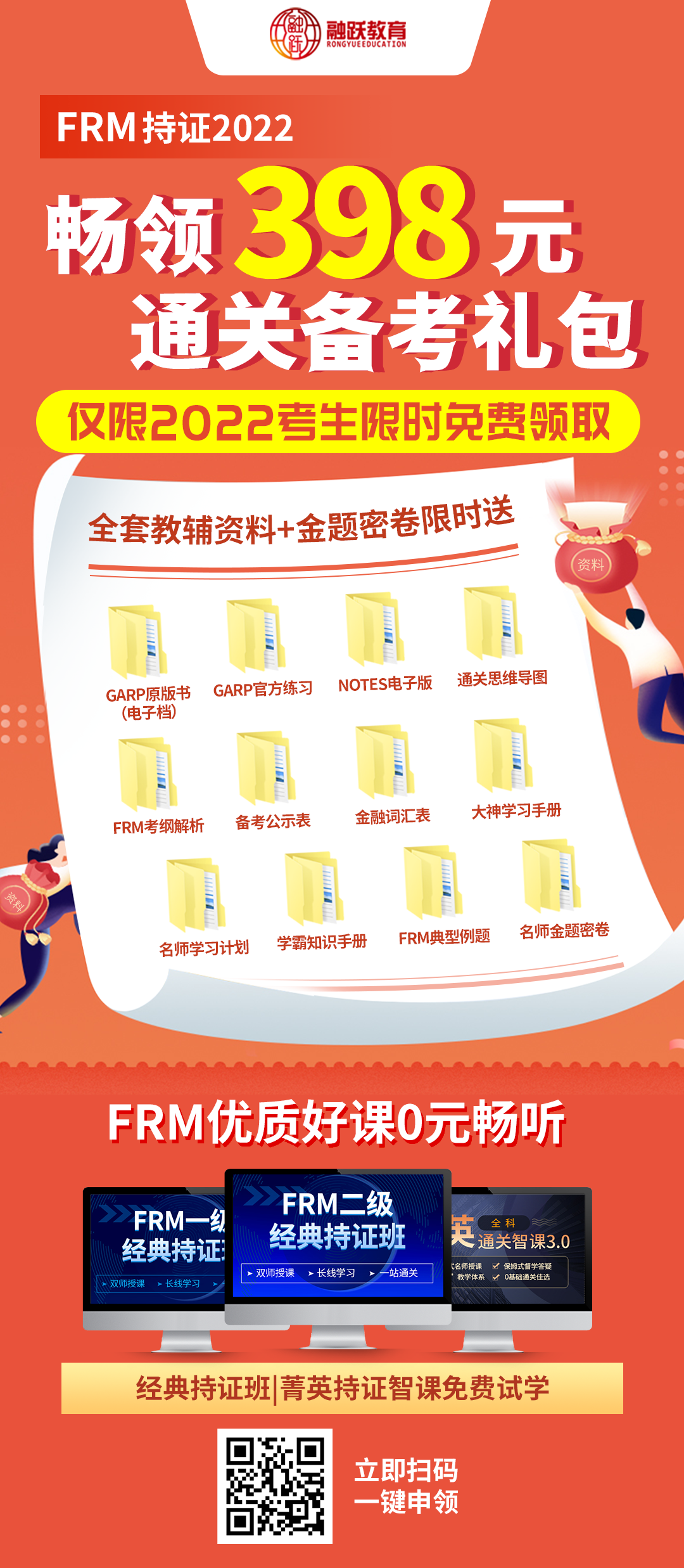2022年FRM二級的考綱整體不大,所有學科的考試占比維持不變。下文是詳細介紹,送給備考的你,希望對你有所幫助!
從學科內容來看,Basel Accords,Liquidity Risk Management, Investment Risk Management這三個部分考點要求完全沒有變化。》》》戳:各科視頻講義+歷年真題+21年原版書(PDF版)免·費領取
Market Risk Management和Operational Risk Management做了小幅的修改,涉及修改的地方主要是描述性詞匯的調整。
變化比較大的就是Credit Risk Management和Current Issue。其中Credit Risk Management一章的原版書參考發生變化,雖然內容比較類似,但是仍然需要根據zui新考綱進行學習。
Current Issue仍然結合熱點來學習,去年的10篇文章中刪除了9篇比較舊的文章,并新增加了和新冠疫情,數字貨幣,人工智能相關的zui新研究文章。
Market risk考點對比 :
市場風險這門課占比仍保持20%,2022年考綱中調整的部分為描述性詞匯的調整,內容上并沒有實質性改變。整體來看,今年的考綱變化對本科目的備考沒有影響。
修改的LOS:(共4條)
Chapter 3. Estimating Market Risk Measures:
Define coherent risk measures. (2021)
Describe coherent risk measures. (2022)
Chapter 6. Backtesting VaR:
Define and identify Type I and Type II errors. (2021)
Identify and describe Type I and Type II errors in the context of a backtesting process. (2022)
Chapter 11. VaR Mapping:
Explain how VaR can be used as a performance benchmark(2021)
Explain how VaR can be computed and used relative to a performance benchmark. (2022)
Chapter 20. Volatility Smiles:
Define volatility smile and volatility skew(2021)
Describe a volatility smile and volatility skew(2022)
Credit Risk考點變化:
從調整上看,可以認為2022年的考綱幾乎沒有變化。有一個Reading因為參考書更新了版本,因此相應的章節有更新,但知識點沒有調整。同時,資產證券化這一個章節引入了一個新的考綱要求,屬于小知識點,涉及內容較少。剩余調整如章節的合并,對復習備考沒有實質影響。
1. 教材變化
知識點結構沒變,但原參考書更新了版本
Chapter 9. Counterparty risk and beyond
考綱要求描述改變,但實質知識點沒變
Chapter 11. Future value and exposure
2022年要求: Explain the general impact of aggregation on exposure, and the impact of aggregation on exposure when there is correlation between transaction values.
2021年要求: Explain the impact of netting on exposure, the benefit of correlation, and calculate the netting factor.
2. 原版書結構調整,實質知識點沒變
2022年將21年舊考綱中的Reading 14 Credit and Debt value adjustment以及Reading 15 Wrong way risk合并,形成2022年的Reading 13 CVA。
3. 新增考綱要求
2022年Reading 17 an introduction to securitization新引入考綱要求
Determine the notional value of the net contract resulting from trade compression and identify the counterparty with the net contract.
Operational risk:考點對比
總體來看,2022年操作風險的考綱有些許變化,主要變動在于操作彈性。對這個話題進行了更新和內容上的擴充。可見,協會越來越注重對于彈性這個領域的探討和研究,這個話題無疑將成為日后這門學科的新重點。不過,這些內容上的調整對于學員備考沒有太大的影響。
新增:
Chapter 25: Operational resilience: Impact tolerance for important business services
? Describe an impact tolerance; explain best practices and potential benefits for establishing the impact tolerance for a business service.
? Provide examples of important business services and explain criteria that firms should use to determine their important business services.
? Explain tools and processes, including mapping and scenario testing, that
financial institutions should use to improve their operational resilience and
remain within their impact tolerance.
? Describe the governance of an operational resilience policy, including the relationships between operational resilience and a firm’s risk appetite, impact tolerance, continuity planning, and outsourcing to third-party providers.
這個章節更新了表述,主要內容未發生實質性變化,依然以定性為主。探討了在操作彈性領域的實踐和指導方針這個主題在全球金融機構中變得越來越重要。
Chapter 26: Principles for Operational Resilience
? Define and describe operational resilience and explain essential elements of operational resilience.
? Explain recommended principles that banks should follow to implement an effective operational resilience approach.
這一章節是上一章節的延續,繼續討論操作彈性,闡述巴塞爾委員會對于操作彈性提出的一系列原則,可見彈性這個話題將越來越值得關注。
調整:
Chapter 5: Banking Conduct and Culture
2021:
? Explain how a bank can structure performance incentives and make staff development decisions to encourage a strong corporate culture.
? Summarize expectations by different national regulators for banks’ conduct and culture.
2022:
? Assess the role of regulators in encouraging strong conduct and culture at banks, and provide examples of regulatory initiatives in this area.
刪減:
Chapter 4: Implementing Robust Risk Appetite Frameworks to Strengthen Financial Institutions
? Explain the relationship between a firm’s RAF and its risk culture and between the RAF and a firm’s strategy and business planning process.
Current Issues考點變化
今年Current issues從去年的10篇文章減少到了今年的8篇文章。大部分內容都是新加入的。
今年7篇新的文章中,有2篇是和新冠疫情的大背景相關,2篇是和人工智能等新興科技相關的,1篇氣候變化,1篇參考利率,1篇數字貨幣。除數字化貨幣外,其它的文章都在過往有過講解,這次是用新的視角重新解讀。隨著數字貨幣在全球的越來越流行,這一趨勢引起了行業的重視,非 常與時俱進。
刪除
去年的10篇文章中,刪除了9篇,只保留了Beyond LIBOR: a primer on the new benchmark rates。
新加入以下文章
1. Machine Learning and AI for Risk Management
這篇文章講解了Machine Learning 和 AI的區別,以及每個類別中使用的技術。Machine Learning 和 AI在信用風險、市場風險、操作風險和監管合規等領域的應用。zui后在風險管理中Machine Learning 和 AI的作用以及局限性和挑戰。
2. Artificial Intelligence Risk & Governance
這篇文章講解了金融公司使用人工智能相關的潛在風險類別,人工智能治理的四個核心組成部分以及與每個組成部分相關的推薦做法,金融公司使用人工智能會如何產生與可解釋性和歧視相關的問題,以及金融公司可以用來降低人工智能風險的做法。
3. Covid-19 and cyber risk in the financial sector
這篇文章講解了cyber risk的原因和實施網絡攻擊的方法。以及COVID-19 對網絡威脅級別的影響。大流行期間金融部門如何受到cyber risk的威脅。cyber risk格局的變化以及減輕風險以穩定金融系統的方法。
4. Holistic Review of the March Market Turmoil
本章主要展示了2020 年 3 月 Covid-19 市場動蕩期間發生的金融市場情況和大流行對金融市場的影響,及其這期間市場壓力的原因。公共部門在 Covid-19 市場動蕩期間恢復金融市場運作的政策反應,以及我們應該從中吸取的教訓。
5.LIBOR transition Case studies for navigating conduct risks
本章討論了對 LIBOR 過渡的監管預期以及這些預期如何幫助市場參與者管理過渡產生的行為風險。以及從賣方和買方的角度分析 LIBOR 過渡的風險。
6.Climate-related risk drivers and their transmission channels
本章講解了與氣候相關的風險驅動因素和潛在影響以及如何給銀行帶來不同類型的風險。
7.The rise of digital money
本章講解了支付方式的不同屬性。數字貨幣快速發展的原因和對銀行業面臨的風險并確定減輕這些風險的方法,以及對應的監管和政策行動。
想要了解更多有關FRM考試相關的內容,可以在線咨詢或添加融躍老師微信(15378732641)!
- 報考條件
- 報名時間
- 報名費用
- 考試科目
- 考試時間
-
GARP對于FRM報考條件的規定:
What qualifications do I need to register for the FRM Program?
There are no educational or professional prerequisites needed toregister.
翻譯為:報名FRM考試沒有任何學歷或專業的先決條件。
可以理解為,報名FRM考試沒有任何的學歷和專業的要求,只要是你想考,都可以報名的。查看完整內容 -
2024年5月FRM考試報名時間為:
早鳥價報名階段:2023年12月1日-2024年1月31日。
標準價報名階段:2024年2月1日-2024年3月31日。2024年8月FRM考試報名時間為:
早鳥價報名階段:2024年3月1日-2024年4月30日。
標準價報名階段:2024年5月1日-2024年6月30日。2024年11月FRM考試報名時間為:
早鳥價報名時間:2024年5月1日-2024年7月31日。
標準價報名時間:2024年8月1日-2024年9月30日。查看完整內容 -
2023年GARP協會對FRM的各級考試報名的費用作出了修改:將原先早報階段考試費從$550上漲至$600,標準階段考試費從$750上漲至$800。費用分為:
注冊費:$ 400 USD;
考試費:$ 600 USD(第一階段)or $ 800 USD(第二階段);
場地費:$ 40 USD(大陸考生每次參加FRM考試都需繳納場地費);
數據費:$ 10 USD(只收取一次);
首次注冊的考生費用為(注冊費 + 考試費 + 場地費 + 數據費)= $1050 or $1250 USD。
非首次注冊的考生費用為(考試費 + 場地費) = $640 or $840 USD。查看完整內容 -
FRM考試共兩級,FRM一級四門科目,FRM二級六門科目;具體科目及占比如下:
FRM一級(共四門科目)
1、Foundations of Risk Management風險管理基礎(大約占20%)
2、Quantitative Analysis數量分析(大約占20%)
3、Valuation and Risk Models估值與風險建模(大約占30%)
4、Financial Markets and Products金融市場與金融產品(大約占30%)
FRM二級(共六門科目)
1、Market Risk Measurement and Management市場風險管理與測量(大約占20%)
2、Credit Risk Measurement and Management信用風險管理與測量(大約占20%)
3、Operational and Integrated Risk Management操作及綜合風險管理(大約占20%)
4、Liquidity and Treasury Risk Measurement and Management 流動性風險管理(大約占15%)
5、Risk Management and Investment Management投資風險管理(大約占15%)
6、Current Issues in Financial Markets金融市場前沿話題(大約占10%)查看完整內容 -
2024年FRM考試時間安排如下:
FRM一級考試:
2024年5月4日-5月17日;
2024年8月3日(周六)上午;
2024年11月2日-11月15日。FRM二級考試:
2024年5月18日-5月24日;
2024年8月3月(周六)下午;
2024年11月16日-11月22日。查看完整內容
-
中文名
金融風險管理師
-
持證人數
25000(中國)
-
外文名
FRM(Financial Risk Manager)
-
考試等級
FRM考試共分為兩級考試
-
考試時間
5月、8月、11月
-
報名時間
5月考試(12月1日-3月31日)
8月考試(3月1日-6月30日)
11月考試(5月1日-9月30日)








